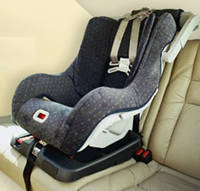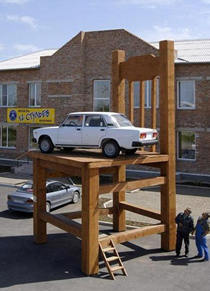
Car Seats
In 2006 the Texas Transportation Institute conducted a survey of seat belt usage among school aged children. They found that fewer than two in ten are properly restrained. According to Safe Kids USA, "in 2005 accidental injury claimed the lives of 5,162 children ages 14 and under, and in 2006 there were more than 6.2 million children’s emergency room visits for accidental injuries in this age group."
A car seat should be used if a child weighs less than 40 pounds. The table below lists the different types and positions of car seats depending on their weight and age.
| INFANTS: Birth to 1 year/ at least 20-22 lbs. | TODDLER: Older than 1 year/ 20-40 lbs. | YOUNG CHILDREN : 4-8 years old/ over 40 lbs., unless 4'9" | |
| TYPE OF SEAT | Infant only or rear-facing convertible | Convertible/ forward-facing | Belt positioning booster seat |
| SEAT POSITION | Rear-facing only | Forward-facing | Forward-facing |
| PROPER USE | Harness straps at or below shoulder level. Never place infants in the front passenger seat of cars with air bags. | Harness straps at or above shoulders. | Must be used with both lap & shoulder belt. Make sure lap belt fits low & tight across lap/upper thigh area & shoulder belt fits snug crossing the chest and shoulder. |
(National Highway Traffic Safety Administration, 2003)
Children will do what you do. Be a good example: always wear your safety belt.
Car Seats for Child Safety
Car seats are an essential part of keeping your child safe while in the car. For parents, it’s important to understand the guidelines for car seat safety and to choose the right car seat for their child. Car seats are designed to protect children from injury in the event of an accident, and they must be used correctly in order to be effective.
According to the National Highway Traffic Safety Administration (NHTSA), all children should ride in a car seat until they are at least 8 years old or have reached 4’9” in height. It is important to always make sure that the car seat correctly fits the child, and that it is installed correctly in the vehicle. Car seats come in a variety of types and sizes, so it is important to choose the right car seat for the child’s age and size.
Infants and toddlers should ride in a rear-facing car seat until they reach the manufacturer’s recommended height and weight limit. Rear-facing car seats are designed to protect the child’s head, neck, and spine in the event of an accident. It is important to make sure that the car seat is properly installed and that the straps are snugly fastened.
Once the child outgrows their rear-facing car seat, they should switch to a forward-facing car seat. This type of car seat is designed to protect the child’s head, neck, and spine in the event of an accident. The straps should be adjusted to fit the child’s height, and the car seat should be securely fastened in the vehicle.
Once the child outgrows their forward-facing car seat, they should switch to a booster seat. Booster seats help to raise the child up so that the seat belt is properly placed across the child’s lap and shoulder. The booster seat should be securely fastened in the vehicle, and the seat belt should be adjusted to fit the child’s height.
It is important to always use the correct car seat for the child’s size and age. It is also important to make sure that the car seat is properly installed and that the straps are snugly fastened. Finally, it is important to make sure that the child is always buckled in the car seat or seat belt, and that they are not left unattended in the vehicle.
Car seat safety is essential for keeping children safe in the car. Parents should always make sure to choose the right car seat for their child’s age and size, and to make sure that the car seat is properly installed and that the straps are snugly fastened. By following these simple guidelines, parents can ensure that their child is safe and secure while in the car.

Crash Protection Seats Defensive Class















